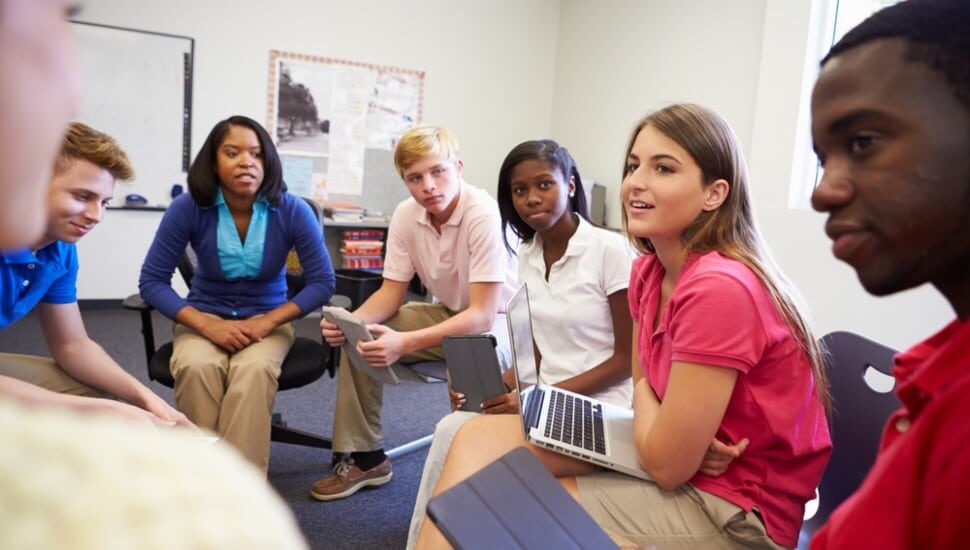Kindness in the Classroom: Facilitating Student-to-Student Kindness

Sixty seconds before they step into the classroom, students are gearing up to engage. How are they preparing themselves for the vulnerability required to master new skills or to make mistakes in front of their peers? To respond to challenges and critiques? To rebound constructively when impacted by the mistakes and missteps of others?
With all they may be processing their lives, what can we do to empower students to filter all their looming interactions through a lens of kindness and compassion toward themselves and each other?
Students may be incapable of preparing themselves for kind, compassionate engagement without their teachers modeling the way.
Through their social cues, teachers can help students reset their expectations and motivations, create shared goals that show students how to treat themselves and others kindly, and motivate restorative responses in vulnerable moments when kindness is needed most.
This begins by modeling self-kindness in front of students who may have never witnessed it before. From there, we can explore student-to-student kindness.
Here are three ways teachers can facilitate kindness between students within the classroom:
Create an atmosphere of belonging, where kindness is normal. As students cross the threshold of their classroom, teachers’ words and actions can make them feel anticipated, wanted, and welcome – or tolerated, endured, or even dreaded.
Students’ often fragile sense of value, contribution, and meaning is being shaped daily by these impressions of belonging or rejection.
Feeling wanted and valued can create anticipation and hope, making room for kindness between students. Teachers can get creative in how they convey belonging, from greeting each person daily by name to developing “class team chants” and other affirming activities, but the key is to find ways to connect with each student and consistently affirm that they are wanted and welcome.
Here is a great resource for kindness activities and ideas that can cultivate belonging in class.
Let the students set the bar – and hold each other to it. At the beginning of the school year, teachers can facilitate a process to let the students communicate and describe what is “okay” and “not okay” for people in the class to say/do to each other.
This activity can model for students how to set boundaries for themselves. Setting kindness goals and expectations in the classroom that include boundaries for how everyone is treated (including the teacher) can help students connect boundaries with compassion.
This is especially crucial when students have not had boundaries or compassion modeled consistently in their lives. Once this question is answered, teachers can write it down and post it, have students sign it, and encourage students to consistently practice communicating and respecting their own boundaries as an act of kindness to themselves and each other.
Give kindness cues. Awkward and tense moments in the classroom are guaranteed. When students make mistakes or expose their unique areas of frailty (personality quirks, crisis, mental/emotional challenges, or learning struggles), the rest of the class will watch the teacher for cues on how to handle it.
Modeling how to move through public mistakes and frailty without shaming shows students what is truly okay and not okay to think, say, and do to themselves and each other when they are most vulnerable.
This makes kindness expectations “real,” creating a constructive and restorative environment even when the teacher is not looking. The ripple effect of critical moments of teachers clearly model kindness in response to a student’s exposed frailty can follow students for the rest of their lives.
Modeling vulnerability, kindness, and compassion for students can create a ripple effect extending far beyond the moment and classroom. As students grow and mature, their ability to extend compassion and kindness to their peers and themselves, will help them to build the resilience and confidence needed to be vulnerable—taking risks, making mistakes, and learning from them—leading to the development and mastery of new skills.
The Lincoln Center for Family and Youth (TLC) is a social enterprise company serving the Greater Philadelphia Area. Among its five divisions, TLC offers School-based Staffing Solutions, Mobile Coaching and Counseling, and Heather’s Hope: A Center for Victims of Crime. These major programs are united under TLC’s mission to promote positive choices and cultivate meaningful connections through education, counseling, coaching, and consulting. For more information, go to: TheLincolnCenter.com/
About the Author
MaryJo Burchard (Ph.D. in Organizational Leadership) is co-founder and principal of Concord Solutions, a Virginia-based consultancy firm focused on helping leaders and organizations thrive while facing major disruption. Concord Solutions offers consulting, coaching, training, research, and keynote speaking surrounding trauma-informed leadership and assessing and building change readiness, trust, and belonging.
Stay Connected, Stay Informed
Subscribe for great stories in your community!
"*" indicates required fields


















![95000-1023_ACJ_BannerAd[1]](https://montco.today/wp-content/uploads/sites/2/2023/03/95000-1023_ACJ_BannerAd1.jpg)





![ForAll_Digital-Ad_Dan_1940x300[59]](https://montco.today/wp-content/uploads/sites/2/2022/06/ForAll_Digital-Ad_Dan_1940x30059.jpg)



















